Text
Beta Mannanase
https://www.bestzyme.com/products/beta-mannanse.html
β-mannanase is a feed hemicellulase fermented by the improved strains using a liquid fermentation technique, and produced by an advanced post-treatment technique. It has properties of high activity, high quality, and good heat-resistant.
Specification of Beta Mannanase
Name
β-mannanase
Product Series Name
EnerGen β-mannanase
Activity
10000-100000U/g
Strain
Aspergillus niger
EC code
3.2.1.78
Form
Powder,Liquid
Carrier
Starch
Color
White or Light yellow
Loss on drying
≤10%
Working T
30℃-80℃
Optimum T
70℃
Working pH
2.0-7.0
Optimum pH
3
Particle size
80% pass 40 mesh
Package
25kg /bag
Storage
Stored 12 months under cover in cool and dry conditions
Caution
Avoid direct sunlight and high temperature
Functions of Beta Mannanase
1. Degrade mannan in feedstuff, like soybean, palm kernel, copra, etc.
2. Eliminate anti-nutritional factors in feed and promote nutrient substance digestion and absorption. Improve the value of feed and lower the cost.
3. Improve the digestibility of the nutrients, release nutrients in the cell, and degrade the complex of mannan and protein and polysaccharide to enhance the absorption of nutrient.
4. Enhance animal’s health. Degrade mannan to mannose, which can significantly promote the proliferation of profitable bacteria represented by bifidobacterium in animal intestine, increase animal’s immunity and reduce the mortality rate of animal.
Definition of Beta Mannanase
One unit of mannanase activity is defined as the amount of enzyme which liberates 1 micromole of reducing sugar per minute from 3 mg/mL of mannan at pH 5.5 and 37℃.
Dosage of Beta Mannanase
Recommended dosage is 100-150g/t with 10000U/g in complete feed.
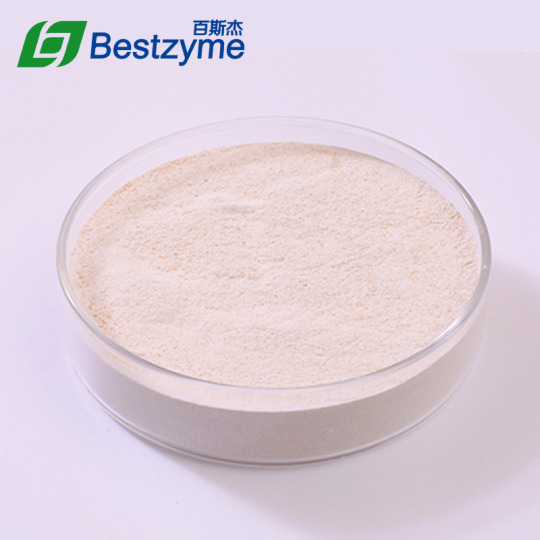
0 notes
Text
Textile
https://www.bestzyme.com/products/textile/
Textile industry is facing tougher and tougher environmental regulations and challenges in the world. Troditional textile process consumes a large amount of chemicals and brings a lot of waste water. The enzymes applied in textile industry provide a mild, environment friendly solutions in desizing and bleach clean-up process. Textile enzyme can improve production methods and fabric finishing. The consumption of chemicals and the impact on the environment can be minimized with the use of enzymes.
Types of Textile Enzymes
Cata™ TEX Catalase
Cata™ TEX Catalase Belongs To Catalase That Specifically Breaks Down Hydrogen Peroxide To Oxygen And Water And Mainly Applied In Bleach Clean-up Process.
SuperAA Tex Desizing Amylase
SuperAA TEX Desizing Amylase Is Applied In Desizing Process Of Textile Manufacture. It Can Hydrolyse α- 1,4 Glycosidic Bond Of Starch Removing Starch-based Size For Improved, Uniform Wet-processing At Broad Temperature Range.
FAQs Of Textile
Why do desizing process is a must in textile industry?
A:
Incompletely size removal may leads to bad effect like uneven dyeing and poor printing. What's more, it may also influence batch-to-batch reproducibility of textile products.
What are the key benefits of enzymatic desizing in textile industry?
A:
(1) Consuming less chemicals and no harm to environment.
(2) Shortening desizing time and boosting fabric quality.
(3) Widely worked on all types of starch-based size.
What are the advantages of enzymatic bleach clean-up?
A:
(1) Lower residue hydrogen peroxide level in shorter time.
(2) Environment friendly process with less water consumption.
(3) Making bleach clean-up process easier and safer.
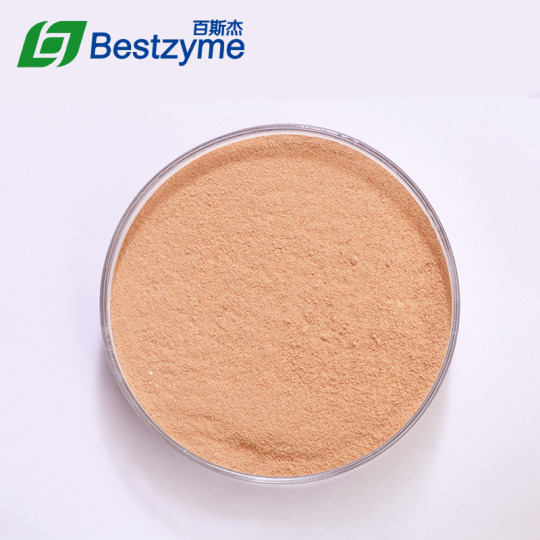
0 notes
Text
Study on the Application of Protease in Food Industry
https://www.bestzyme.com/study-on-the-application-of-protease-in-food-industry.html
The role of protease in meat products
The content of muscle fiber protein and collagen in meat is the main reason that affects the tenderness of meat. After the animal is slaughtered, protease acts on the muscle tissues to degrade the muscle fiber protein and collagen through a series of complex chemical reactions, thereby increasing the tenderness of the meat and turning the muscle into edible meat, but during this period the enzymes The vitality of the enzyme is also changing, and the enzymatic hydrolysis of endogenous proteases is far from enough. Protease can also improve various nutritional indicators in meat food, which is beneficial to the development of meat food deep processing industry. Studies have found that an appropriate amount of trypsin can promote the hydrolysis of proteins in meat and increase flavor substances such as small amino acid peptides, which is of great significance for improving the flavor of meat foods.
The role of protease in baked goods
Baked food mainly refers to bread, cakes and biscuits with flour as the main raw material, which is the convenience food prepared by baking through a series of complicated process methods. Flour contains amylase, protease, pentosanase and other enzymes. The main function of protease is to reduce the gluten of flour, improve the plasticity of gluten, increase dough volume, improve dough toughness, and shorten dough forming time.
The role of protease in beverages
Liquid beverages such as beer and tea beverages contain a lot of protein. During storage, the protein collides and precipitates, which seriously affects the taste of the beverage and subsequent sales. However, protease enzyme products preparations can effectively solve the above situation. The protease acts on the protein to decompose it into small peptides and amino acids, which not only alleviates the precipitation phenomenon in the drink but also increases the flavor substances contained in it. The study found that the content of amino nitrogen in tea juice after protease treatment increased by 13% to 39%, and the umami taste and flavor of the tea soup were effectively improved. By adding neutral protease in beer production, the unstable substances are removed, the content of macromolecular protein is reduced, and the stability of beer during storage is improved. Studies have shown that protease can also promote the diastatic fermentation to remove the unpleasant taste of fruit wine and wine, and also have a significant effect on eliminating the turbidity of fruit wine, wine and rice wine. In addition, protease has also made a great contribution to the research and development of new beverages. The use of neutral protease to develop the orange juice peanut peptide beverage that is easily digested and contains high nutrition and unique flavor, which can improve the protein demand of special populations in a way.

0 notes
Text
Xylanase
https://www.bestzyme.com/products/xylanase.html
Xylan is contained commonly in a variety of feed ingredients, like wheat, rye, corn, cereal by-products, soybean meal, etc. Whereas, xylan is an indigestible compound for non-ruminant, and causes a significant anti-nutritional affect by increasing chyme viscosity and preventing absorption of protein and energy. Incorporating xylanase in diets help remove anti-nutrition of xylan and reduce feed cost savings.
Specification of Xylanase
Name
Xylanase
Product Series Name
EnerGen Xyl
Activity
10000-600000U/g
Strain
Aspergillus niger
EC code
3.2.1.8
Form
Powder
Carrier
Starch
Color
White, Light yellow
Loss on drying
≤10%
Working T
30-70℃
Optimum T
60℃
Working pH
2.0-7.0
Optimum pH
4
Particle size
80% pass 40 mesh
Package
25kg /bag
Storage
Stored 12 months under cover in dark, cool and dry conditions
Caution
Avoid direct sunlight and high temperature
Functions of Xylanase
1. Break down the structure of the cell wall, especially xylan, reduce the viscosity of chyme in the intestinal tract, and improve the digestion efficiency of nutrients.
2. Improve energy utilization, reduce feed costs and improve feed quality.
3.Generate a large number of xylo-oligosaccharides, improve gut health, and stimulate animal performance.
Definition of Activity Xylanase
One unit of xylanase activity is defined as the amount of enzyme that liberates 1 micromole of reducing sugar per minute from 5.0 mg/mL of xylan at pH 5.5 and 37℃.
Dosage of Xylanase
Recommended dosage in the complete feed of xylanase with 10000 U/g:100-300g/t.
Application of Xylanase
1. The matrix value of xylanase(300g/t)
2. Application case of xylanase
(1) Improve the performance of growing pigs on wheat-based diet
Animal: growing pigs, 40-60kg
Control: Wheat meal diet; Test: Control +xylanase
(2) Improve the performance of broiler on mixed grain and byproducts diet.
Animal: AA broilers, 1-42D
Control: Corn-wheat-byproduct meal diet; Test: Control +xylanase

0 notes
Text
Starch/Ethanol
https://www.bestzyme.com/products/starch-ethanol/
To make full use of starch-base raw materials, the starch must be hydrolyzed to small molecules in order to produce sweeteners or provide fermentable sugars. Starch & ethanol enzyme can catalyze this kind of reactions and convert starch to glucose. What's more, it can also hydrolyze the protein in starch-based feedstock to release more nutrition, increasing the yield of fermentation products. As a kind of food addictive, starch & ethanol enzyme plays an important role on starch sweetener and ethanol industry improving production efficiency greatly.
Types of Starch and Ethanol
SuperAA™ X5 Alpha-Amylase
SuperAA™ X5 Alpha-Amylase can hydrolyze α‐1,4‐glucosidic bonds of starch to reduce slurry viscosity with 'liquefy' effect producing short chains of dextrin and small amount of oligosaccharides.
SuperAA C5 Alpha-Amylase
SuperAA C5 Alpha-Amylase can hydrolyze α‐1,4‐glucosidic bonds of starch to reduce slurry viscosity with 'liquefy' effect producing short chains of dextrin and small amount of oligosaccharides. It is widely applied for corn feedstock ethanol fermentation.
ALCGEN™ P10/P15 Acid Protease
ALCGEN™ P10/P15 Acid Protease belong to acid protease specifically for alcohol production. It can hydrolyze most proteins randomly on a wide range of substrates.
FastLIQ STAR150 Alpha-Amylase
FastLIQ STAR150 Alpha-Amylase can hydrolyse α- 1,4 glycosidic bond randomly. The viscosity of starch slurry decreases rapidly because of the high reaction rate and yielding short chain dextrins and a little oligosaccharides. FastLIQ STAR150 Alpha-amylase can be applied in liquefaction process based on starchy materials to produce starch sweetener.
HighDEX™ Ultra3.0 Glucoamylase
HighDEX™ Ultra3.0 Glucoamylase is a compound enzyme which can hydrolyse α- 1,4 glycosidic bond and α- 1,6 glycosidic bond converting dextrins to glucose with almost no transglycosylation effect.
FAQs Of Starch/Ethanol
What are the advantages of enzymatic hydrolysis sweetener compared to the one with acid hydrolysis process?
A:
(1) The factory can get higher convertion rate utilizing enzyme instead of acid.
(2) The enzymatic reaction is under mild conditions with less operational risk.
(3) The taste is better than traditional acid hydrolysis sweetener.
Why do yeast need enzyme in ethanol fermentation?
A:
(1) Yeast can't utilize starch directly.
(2) Enzyme can break down long starch chain into small molecules which can be absorbed by yeast to produce ethanol thus improve utilization rate of starch.
What's the purpose of adding protease in starch-based feedstock fermentation?
A:
Corn starch is the common feedstock applied in ethanol production and it also contains a small amount of protein. Protease can hydrolyse protein to free amino nitrogen providing nutrition to yeast and finally increase ethanol yield.

0 notes
Text
Protease
https://www.bestzyme.com/products/protease/
Protease could hydrolyzes protein. It can efficiently hydrolyze the protein in feed materials and improve the utilization rate of protein. At the same time, it has a good degradation effect on protein anti-nutritional factors such as antigen protein.
Keratinase
Keratinase is a kind of alkaline serine protease which can efficiently open disulfide bonds. It not only improves the digestibility of protein in soybean meal, but also has a good degradation effect on gliadin in corn, wheat, DDGS and other raw materials. It is a kind of protein with wide applicability.
Acid Protease
Acid protease plays an improtant role in the animal's stomach and can cooperate with pepsin to act on the protein in feed raw materials.
Neutral Protease
Neutral protease is a kind of protease which works in pH neutral environment. It mainly plays a role in the small intestine of animals, and can cooperate with trypsin to act on the protein in feed raw materials.
Alkaline Protease
Alkaline protease is a kind of protease which works in neutral to alkaline environment. It mainly plays a role in animal intestinal tract and can cooperate with trypsin to act on protein substrate in feed raw materials.
FAQs Of Protease
Why protease should be used in feed?
A:
①Supplement endogenous digestive enzymes. The digestive system of young livestock and poultry is not fully developed, and the secretion of endogenous proteases is insufficient. The current breeding mode also causes the secretion of digestive enzymes to be inconsistent with the demand; in addition, the types of endogenous proteases are insufficient. There is no corresponding enzyme to decompose alcohol soluble protein, keratin, etc., so extra addition is required.
②Reduce costs. Expanding the use of unconventional raw materials reduces the pressure on formula costs for enterprises, while effectively increasing the digestibility of feed protein, improving animal production performance, and increasing economic benefits for farmers.
③Improve the breeding environment. Protease improves the digestion and absorption rate of protein in raw materials. On the one hand, it reduces ammonia emissions, improves the environment of the livestock farms, and reduces the incidence of respiratory diseases. On the other hand, it also reduces the nitrogen pollution caused by breeding.
Will the exogenous addition of protease affect the animal's own protease secretion?
A:
The effect of adding exogenous protease on the activity of endogenous enzymes in the digestive tract of animals is affected by multiple factors such as animals (type, physiological stage, age), feeding environment, diet type, etc. The mechanism is very complicated. Most studies have shown that the addition of exogenous proteases can stimulate or promote the secretion of endogenous enzymes in animals, but there are also individual studies that show that the addition of low doses of exogenous enzymes promotes the secretion of endogenous enzymes in the digestive tract of animals, while high doses Exogenous enzymes have a certain inhibitory effect on the secretion of endogenous enzymes in the digestive tract of animals. Some studies (Inborr, 1990) believe that feed enzyme preparations are generally fermented by microorganisms, and have no homology with endogenous enzymes secreted by the digestive tract of animals, and so-called "feedback inhibition" is unlikely; There is a complementary relationship between the restriction site of the source digestive enzyme and the restriction site of the endogenous digestive enzyme, which not only does not inhibit, but also has a synergistic effect.
How to choose the right feed protease?
A:
Considering the physiological characteristics of animals and the composition of feed ingredients, when selecting feed protease, we should pay attention to following details:
① The right protease should have restriction sites that are complementary to the endogenous proteases so it can degrade the proteins that cannot be hydrolyzed by the endogenous enzyme;
② The optimal reaction conditions are consistent with the conditions of the animal's digestive tract, so the protease can effectively degrade the substrate in vivo;
③ A wide range of applicable substrates, capable of degrading various animal and plant raw material proteins (nutritive and anti-nutritive);
④ It has good heat resistance and can be applied to the preparation of pellet feed;
⑤ Not affected by trypsin inhibitor;
⑥ There is no antagonism with other enzyme preparations.

0 notes
Text
Beta Mannanse
β-mannanase is a feed hemicellulase fermented by the improved strains using a liquid fermentation technique, and produced by an advanced post-treatment technique. It has properties of high activity, high quality, and good heat-resistant.
Specification of Beta Mannanse
Name
β-mannanase
Product Series Name
EnerGen β-mannanase
Activity
10000-100000U/g
Strain
Aspergillus niger
EC code
3.2.1.78
Form
Powder,Liquid
Carrier
Starch
Color
White or Light yellow
Loss on drying
≤10%
Working T
30℃-80℃
Optimum T
70℃
Working pH
2.0-7.0
Optimum pH
3.0
Particle size
80% pass 40 mesh
Package
25kg /bag
Storage
Stored 12 months under cover in cool and dry conditions
Caution
Avoid direct sunlight and high temperature
Functions of Beta Mannanse
1. Degrade mannan in feedstuff, like soybean, palm kernel, copra, etc.
2. Eliminate anti-nutritional factors in feed and promote nutrient substance digestion and absorption. Improve the value of feed and lower the cost.
3. Improve the digestibility of the nutrients, release nutrients in the cell, and degrade the complex of mannan and protein and polysaccharide to enhance the absorption of nutrient.
4. Enhance animal’s health. Degrade mannan to mannose, which can significantly promote the proliferation of profitable bacteria represented by bifidobacterium in animal intestine, increase animal’s immunity and reduce the mortality rate of animal.
Definition of Beta Mannanse
One unit of mannanase activity is defined as the amount of enzyme which liberates 1 micromole of reducing sugar per minute from 3 mg/mL of mannan at pH 5.5 and 37℃.
Dosage of Beta Mannanse
Recommended dosage is 100-150g/t with 10000U/g in complete feed.
https://www.bestzyme.com/products/beta-mannanse.html

0 notes
Text
Beta Glucanase
β- Glucanase is a feed hemicellulose produced by a liquid submerged fermentation and advanced post-treatment technique. β- Glucanase play a role in hydrolyzing 1, 3 and 1, 4 glycosidic bonds. It can break up β-glucan in the barley and cereal endosperm cell wall, reduce the effect of anti nutritional factors, improve absorption of nutrients, feed conversion efficiency and animal growth performance.
Specification of Beta Glucanase
Name
β- Glucanase
Product Series Name
EnerGen β- Glucanase
Activity
100000U/g
Donor strain
Trichoderma longibrachiatum
Host strain
Trichoderma longibrachiatum
Form
Powder
Carrier
Starch
Color
Light brown
Loss on drying
≤10%
Particle size
80% pass 40 mesh
Package
20kg /bag
Storage
Stored 12 months under cover in cool and dry conditions
Caution
Avoid direct sunlight and high temperature
Functions of Beta Glucanase
1. Cooperate with xylanase and cellulase, destroy the cell wall of plant, degrade β-glucan in wheat/barley diets, improve the absorption of nutrients and feed utilization efficiency.
2. Reduce the viscosity of β-glucan, improve the ecological environment and morphology of animal digestive tract.
3. Increase the activity of endogenous enzyme in animal intestinal tract.
4. Change intestinal microbial flora and reduce the accumulation of harmful bacteria. It also enhances immunity and improves growth performance of stock and poultry.
Features of Beta Glucanase
pH range: the optimum pH is 4..5-5.5, valid pH range is 2.0-7.0, excellent acidic resistance.
Valid pH range
Acidic resistance test
2. Temperature range: valid temperature range is 30-70℃, the optimum temperature is 65℃, show very good thermostable stability.
Valid temperature range
Heat resistance test
Definition of Activity Beta Glucanase
One unit (U) of β-glucanase activity is defined as the amount of enzyme which liberates 1 μmol reducing sugar per minute from 4mg/mL substrate (the barley β-glucan) solution at 37.0℃ and pH 5.5.
Dosage of Beta Glucanase
The recommended dosage is 50-100g/t with 10000 U/g in complete feed.
https://www.bestzyme.com/products/beta-glucanase.html
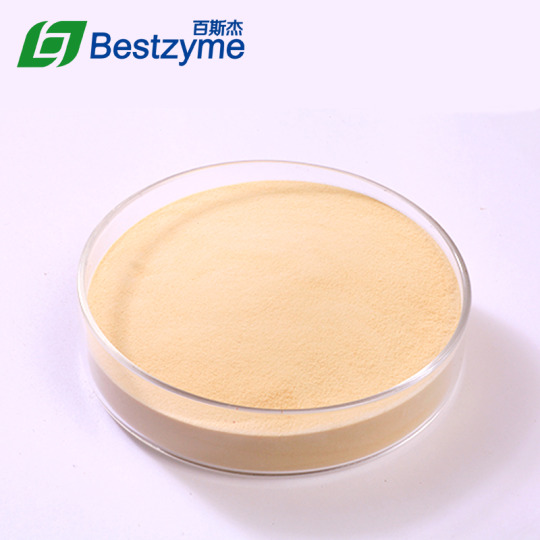
0 notes
Text
Alpha Galactosidase
α-Galactosidase is a feed hemicellulose produced by a liquid submerged fermentation and advanced post-treatment technique. α-Galactosidase can degrade galactosides, such as stachyose and raffinose, which can be fermented by microorganism in gut and cause flatulence in the intestine. α- galactosidase prevents flatulence and diarrhea.
Specification of Alpha Galactosidase
Name
α-galactosidase
Product Series Name
EnerGen α-galactosidase
Activity
2000U/g
Form
Powder
Carrier
Starch
Color
Light yellow
Loss on drying
≤10%
Working T
30-70℃
Optimum T
60℃
Working pH
2.0-7.0
Optimum pH
5.0
Particle size
80% pass 40 mesh
Package
25kg /bag
Storage
Stored 12 months under cover in dark, cool and dry conditions
Caution
Avoid direct sunlight and high temperature
Definition of Activity Alpha Galactosidase
One unit of α-galactosidase activity (U) is defined as the amount of enzyme which liberates 1 millimole of paranitrophenol per minute from 5 mmol/L of paranitrophenol-α-D-galactopyranose solution at pH 5.5 and 37 ℃.
Functions of Alpha Galactosidase
1. Destroy the cell wall structure synergized with the other enzymes and promote the release of nutrients.
2. Degrade galactosides such as stachyose and raffinose. Inhibition fermentation of microorganism in hindgut, reduce harmful substances such as amine and methane.
3. Improve the activity of endogenous protease, promote the production of polypeptide and control the diarrhea caused by indigestion.
4. Increase animal's immunity, and improve animal health.
Dosage of Alpha Galactosidase
Recommended dosage in complete feed of α-galactosidase with 2000 U/g:50-150g/t. Increase or reduce the dosage according to the particular feed materials and season.
https://www.bestzyme.com/products/alpha-galactosidase.html
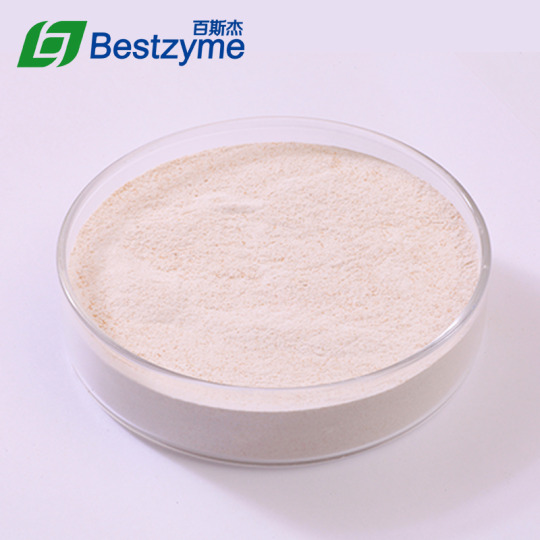
0 notes
Text
Alpha Amylase
α- Amylase is an enzyme preparation abstracted from bacillus lincheniformis through deep-layer liquid fermentation, and is applied in such industries as bio-pharmacy, starch sugar, alcohol, beer, monosodium glutamate, fermentation and fruit juice.
Specification of Alpha Amylase
Name
α- Amylase
Product Series Name
EnerGen α- Amylase
Activity
5000-10000U/g
Strain
Bacillus licheniformis
EC code
EC 3.2.1.1
Form
Powder, Liquid
Carrier
Starch
Color
Light brown, brown
Loss on drying
≤ 10%
Working pH
4.5-7.0
Optimum pH
5.5-6.0
Working T
50℃-90℃
Optimum T
60℃
Particle size
80% pass 40 mesh
Package
25kg /bag
Storage
Stored 12 months in dark, cool and dry conditions
Caution
Avoid direct sunlight, high temperature
Functions of Alpha Amylase
(1) α- amylase can increase feed conversion ratio and improve production performance.
(2) α- amylase can effectively decompose resistant starch which produces feed raw material itself and in the process of machining, improving energy utilization rate.
Features of Alpha Amylase
(1)High tolerance to animal acid gastrointestinal environment.
pH range: valid pH range is 2.0~7.0; the optimum pH is 5.0.
(2) Heat-resistant is good.
Heat-treatment for 10min in different temperature at pH6.0
Definition of Activity Alpha Amylase
One unit of amylase activity (U) is defined as 1g solid enzyme(or 1ml liquid enzyme),liquefies 1mg soluble starch at 60℃ and pH6.0 in 1min.
Dosage of Alpha Amylase
Recommended dosage in complete feed of α- amylase with 7000 U/g:80-100g/t.Add to premixed feed and concentrated feed in proportion.
https://www.bestzyme.com/products/alpha-amylase.html

0 notes
Text
Alkaline Protease
The alkaline protease was developed by Jinan Bestzyme Bio-Engineering Co., Ltd. This product is made from improved bacillus licheniformis through liquid deep fermentation and advanced post-processing technology. The product has stable enzymatic properties and high efficiency, promotes the development of endocrine and digestive organs, improves animal immunity, degrades the anti-nutritional factors in feed, and improves animal disease resistance and production performance.
Specification of Alkaline Protease
Name
Alkaline protease
Product Series Name
NutriGen Alkaline protease
Activity
100000-200000 U/g
Strain
Bacillus licheniformis
EC code
EC 3.4.21.14
Form
Powder
Carrier
Sulfate
Color
Brown,Light brown
Loss on drying
≤ 10%
Working pH
6.0-12
Optimum pH
11
Working T
35℃-65℃
Optimum T
55℃
Particle size
80% pass 40 mesh
Package
25kg /bag
Storage
Stored 6 months in dark, cool and dry conditions
Caution
Avoid direct sunlight, high temperature
Definition of Activity Alkaline Protease
One unit (U) of alkaline protease activity is defined as the amount of enzyme which liberates 1 μg tyrosine per minute from substrate casein at 40℃ and pH 10.5.
Functions of Alkaline Protease
Supplement the endogenous protease in animals, improve animal digestion function and improve feed utilization rate.
Reduce feed anti nutritional factors, improve protein digestibility, reduce feed costs.
Enhance animal immunity and reduce diarrhea.
Improve livestock environment and reduce ammonia emissions
Dosage of Alkaline Protease
Recommended dosage is 100g/t with 50000 U/g in complete feed.
https://www.bestzyme.com/products/alkaline-protease.html
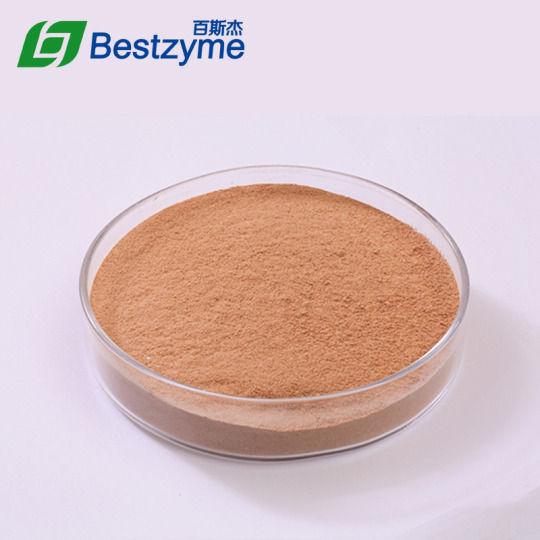
0 notes
Text
Acid Protease
Protease catalyzes peptide bond and hydrolyzes protein into peptone, hydrazone, polypeptide and amino acid. Activity center of acid protease includes aspartic acid. Priority cut open peptide bond of aromatics or hydrophobic amino acids and produce small peptide and amino acid.
Specification of Acid Protease
Name
Acid protease
Product Series Name
NutriGen Acid protease
Activity
50000-100000 U/g
Strain
Aspergillus niger
EC code
3.4.99.11
Form
Powder,Liquid
Carrier
Starch
Color
Brown
Loss on drying
Max 10%
Working pH
2.0-4.0
Optimum pH
2.5
Working T
30℃-65℃
Optimum T
55℃
Particle size
80% pass 40 mesh
Package
20kg /bag
Storage
Stored 6 months under 25℃
Caution
Avoid direct sunlight and high temperature
Functions of Acid Protease
1. Supplement the deficiency of endogenous protease for animal.
2. Increase protein digestibility in animal feed and reduce the dosage of protein in feed formula.
3. Decrease the difference of feedstuff from different area and stabilize production performance.
4. Protect the environment by decreasing pollution from nitrogen.
Definition of Activity Acid Protease
One unit (U) of protease activity is defined as the amount of enzyme which liberates 1 μg tyrosine per minute from substrate casein at 40℃ and pH 3.0 under the conditions of the test.
Dosage of Acid Protease
Recommended dosage is 50-100g/t with 50000U/g in complete feed.
https://www.bestzyme.com/products/acid-protease.html

0 notes
Text
HighDEX™ Ultra3.0 Glucoamylase
HighDEX™ Ultra3.0 Glucoamylase is developed for the customers with high requirements on saccharification and can achieve expectant DX value fast. HighDEX™ Ultra3.0 Glucoamylase is a kind of mixture with glucoamylase and pullulanase in proper proportion. The high-activity glucoamylase is derived from Aspergillus niger who can hydrolyze α-1,4-glucosidic bonds fast. It also has the ability, in a manner, to hydrolyze α-1,6-glucosidic bonds. The pullulanase with high heat and wide pH stability derived from Bacillus subtilis, who can efficiently hydrolyze α-1,6-glucosidic bonds to produce straight-chain dextrin quickly. With the help of HighDEX™ Ultra3.0 Glucoamylase, users can achieve high DX value after saccharification with almost no transglycosylation effect.
An innovative cost-effective compound enzyme from Bestzyme ensuring higher dextrose level in starch & sweetener industry.
HighDEX® Ultra 3.0 is developed for the customers with high requirements on saccharification and can achieve expectant DX value fast.
Benefits of HighDEX™ Ultra3.0 Glucoamylase
It is a kind of mixture with glucoamylase and pullulanase in proper proportion. It is widely utilized in saccharification and can achieve high DX value with almost no transglycosylation effect which brings economic benefits to starch & sweetener producers.
The DX value of saccharification would be higher than 96%.
Wide pH stability, flexibility in process control.
Saccharification can be processed in higher temperature and drier substance concentrations.
Lower reverse reaction rate.
HighDEX® Ultra 3.0 turns liquefied starch or dextrin into high purity glucose through the synergistic effect of glucoamylase and pullulanase. The applying effect depends on processing temperature, pH, time and the quantity of dry substrate, etc.
Achieve high dextrose level.
HighDEX® Ultra 3.0 convert the dextrin into glucose very fast with no reverse reaction rate to achieve higher dextrose level in shorter time compared to the main competitor in saccharification.
Excellent performance at higher dry substance.
Smoothly running of saccharification with high dextrose target and high dry substance is a great challenge for most starch & sweetener producers and HighDEX® Ultra 3.0 provides an ideal solution for them. Base on the comparison data we can find the breakthrough of peak dextrose level using HighDEX® Ultra 3.0. It can not only increase the dextrose conversion rate but also maintain steady performance even with higher dry solids. In other words, it help to increase production efficiency and reduce energy cost dramatically.
No transglycosylation effect during saccharification
The production strain of HighDEX® Ultra 3.0 has no gene segment of transaminase with the help of Bestzyme R&D personnel. You don’t need to worry about dextrose decreasing when prolong saccharificaiton time. Bestzyme products will show robust performance when face parameter fluctuation and adjustment to minimize the adverse effects.
https://www.bestzyme.com/products/highdex-ultra3.html

0 notes
Text
Feed Enzyme
Feed enzyme is a widely recognized feed additive, which includes Phytase, Non Starch Polysaccharides enzymes, functional enzyme. The functions of enzyme are breaking the plant cell wall to release more nutrition, improving the digestive rate of feed with the endogenous enzyme, degrading the antinutrition factor of the grain such as corn, wheat, soybean mill, decreasing the viscosity of the chime, promoting the absorptivity of the nutrition from feed, improving gut health via inhibiting harmful bacteria, helping the intestinal tract to establish a good environment. Enzyme is an ideal feed additive for saving cost and increasing animal health. Bestzyme feed enzyme have three main series products. They are PhosGen series, EnerGen Series and NutriGen Series.
Types of Feed Enzyme
Phytase
Strong Release of Phytate Phosphorus and Save Feed Cost.
Glucose Oxidase
Significantly Improve Animal Intestinal Health, Improve Production Performance, Reduce The Use Of Drugs, And Promote A Comprehensive Ban On Feed Antibiotics.
Beta Mannanse
Effectively Degrade Mannans To Produce Prebiotic Mannose Oligosaccharides.
Xylanase
Effectively Degrade Xylan, Reduce Chyme Viscosity And Improve Nutrient Digestibility.
Beta Glucanase
Effectively Degrade β-glucan In The Cell Walls Of Wheat And Cereals, Reduce Its Anti-nutritional Effects.
Cellulase
Efficiently Break Cell Walls, Effectively Degrade Cellulose, And Convert It Into Absorbable Reduced Sugar.
Alpha Galactosidase
Effectively Degrade The Flatulence Factors Such As Raffinose And Stachyose In Beans, And Improve The Digestibility Of Energy Ingredients And Nutrients In Animals.
Pectinase
Hydrolyze Pectin, Destroy Cell Walls And Release Nutrients.
Alpha Amylase
Resistant To Feed Pelleting, Improve Starch Utilization.
Protease
Improve Protein Digestibility And Reduce Nitrogen Emissions From Breeding.
EnerGen Supreme
Comprehensively Degrade Nsp To Improve Energy Utilization.
Bestzyme CE804 For Pig
Improve Nutrient Digestibility, Improve Intestinal Health, And Improve Production Performance.
Bestzyme CE806 For Poultry
Improve Nutrient Digestibility, Improve Uniformity, And Prevent Overfeeding.
FAQs Of Feed Enzymes
Why do animals need feed enzymes?
A:
(1)The digestive system of young animals is not well developed and the secretion of digestive enzymes is insufficient. The aging of animals will also cause the reduction of digestive enzyme secretion. Coupled with environmental emergency stimuli such as transfer, transportation, and cooling, the secretion of digestive enzymes will also be severely affected. That's why animals need digestive feed enzymes to supplement the deficiency of endogenous enzymes
(2)The animal itself does not secrete phytase and NSP enzyme, so it must be added externally to ensure the animal’s high digestibility and utilization of these ingredients
(3) In addition to nutrients such as protein, carbohydrate and fat, feed also contains many anti-nutritional factors, such as phytic acid, non-starch polysaccharides (xylan, mannan, dextran, cellulose, pectin, galactosides and other cell wall components), proteins (trypsin inhibitors, plant lectins), starches (resistant starch), etc. Feed enzymes are added in order to reduce the anti-nutritional effects of anti-nutrients, increase the digestibility of nutrients, and ultimately increase digestibility of feed
What are the similarities and differences in the selection of feed enzymes in the juvenile and adult stages of animals?
A:
At the young animal stage: The digestive system is not well developed and many digestive enzymes are insufficiently secreted. Therefore, it is recommended to add digestive feed enzymes, especially protease, amylase, lipase, and also add phytase, NSP enzyme and other animals feed enzymes that are not produced by animal itself to promote digestion and absorption of nutrients in young animals, and also reduce common problems such as diarrhea and indigestion
At the adult animal stage: The digestive function of the animal is relatively good, and it has good digestion ability for a variety of nutrients. If the adult animal diet contains more anti-nutritional factors, β-glucanase and pectin should be used in NSP enzyme preparations, such as cellulase and phytase can eliminate the adverse effects of anti-nutritional factors. Digestive enzymes can also be added to cope with insufficient secretion of digestive enzymes due to stress and further improve the digestion effect of animals on feed
What are the differences between wheat and corn in physical and chemical composition and nutrition?
A:
1.(1)Wheat has lower energy value than corn, and contains more anti-nutritional factors, which is not easy to digest, mainly including arabinoxylan, cellulose, glucan, etc. Adding wheat complex enzymes can increase energy by 4%~7%
(2) Wheat's protein content is 13.5% which is higher than corn (8%), but the amino acid balance of wheat is slightly worse than corn.
(3)The content of calcium, phosphorus and phytase in wheat is higher than corn, and the utilization rate of phosphorus is also higher.
(4)The crude fat content of wheat is lower than that of corn, and the content of linoleic acid is also much lower than that of corn. Using wheat instead of corn in the diet can increase the hardness of animal fat and improve the quality of pork.
2. Application of enzyme solutions using wheat to replace corn.
(1)When the price of wheat and corn are not much different, wheat is cost-effective and you can use wheat to replace part of the corn.
(2) The maximum ratio of wheat to replace corn: 30% for nursery pigs, 40% for growing pigs, 60% for fattening pigs; 15% for small chickens, 25% for medium chickens, 35% for large chickens; 30% for broilers; 15% for small ducks and 35% for medium ducks, Big Duck 45%.
(3)Adding a variety of NSP enzymes can solve the problem of high NSP content in wheat diet: Adding high-efficiency xylanase can completely cut the branch chain and main chain of xylan, combined with β-glucanase and high-activity amylase, can improve the digestion and utilization rate of various nutrients in the feed.
https://www.bestzyme.com/products/feed-enzyme/

0 notes
Text
1.Cellulase
Cellulase is extracted from choiceness strains by microbial fermentation technology, and advanced post-processing techniques. As a kind of multi-component compound enzyme, cellulase contains several kinds of enzyme with synergistic effect which can catalyze the hydrolysis of cellulose and generate oligosaccharide and cellose which finally decomposed into glucose.
Specification of Cellulase
Name
Cellulase
Product Series Name
EnerGen Cellulase
Activity
10000-20000U/g
Donor strain
Trichoderma reesei
EC Code
EC 3.2.1.4
Form
Powder
Carrier
Starch
Color
Light brown
Loss on drying
≤10%
Working pH
2.0-7.0
Optimum pH
5.0
Working T
30℃-80℃
Optimum T
60 ℃
Particle size
80% pass 40 mesh
Package
25kg /bag
Storage
Stored 12 months under cover in cool and dry conditions
Caution
Avoid direct sunlight and high temperature
Functions of Cellulase
1. Effectively degrade cellulose, destroy the cell wall, remove the protection to inside nutrients and increase digestibility and absorptivity.
2. Reduce the physical injury of cellulose to animal intestine, reduce intestinal disease.
3. Improve the utilization of unconventional feed, reduce feed cost.
Definition of Activity Cellulase
One unit (U) of cellulase activity is defined as the amount of enzyme which liberates 1 μmol reducing sugar per minute from 4mg/mL substrate (carboxymethylcellulose) sodium at 37℃ and pH 5.5.
Dosage of Cellulase
Recommended dosage is 15-30g/t with 10000 U/g in complete feed.
https://www.bestzyme.com/products/cellulase.html

1 note
·
View note